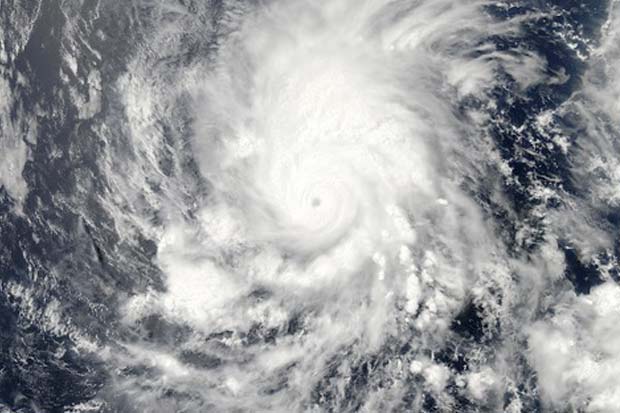Amanda: First Hurricane of 2014 Seen from Space (Photo)

The first named storm of the 2014 hurricane season was caught on camera on May 25, spinning southwest of Manzanillo, Mexico.
Hurricane Amanda was churning in the eastern Pacific as a Category 4 storm when this image was taken, according to NASA's Earth Observatory. The storm's winds reached 155 mph (250 km/h) over Memorial Day weekend, securing it a place in the record books as the strongest May hurricane ever seen.
Fortunately, Amanda was far from land at the time. The storm weakened slightly after this image was captured, and then gained strength again yesterday. As of today (Wednesday), Amanda had weakened again and become a tropical storm, according to the National Weather Service's National Hurricane Center. The storm is now located 562 miles (905 km) southwest of the tip of the Baja Peninsula, and has maximum sustained winds of about 65 mph (105 km/h). The storm is not expected to affect land, and may weaken further to become a tropical depression by Friday. [Hurricanes from Above: Photos of Nature's Biggest Storms]
Early bird storm
The Eastern Pacific hurricane season starts May 15 and runs through Nov. 30. The Atlantic hurricane season is set to kick off soon: It starts June 1 and also ends on Nov. 30.
Amanda was an early bird, forming as a tropical storm on May 23, according to Weather Underground meteorologist Jeff Masters. On average, the first eastern Pacific tropical storm doesn't form until June 10, and the first hurricane blows on the scene around June 26, Masters wrote.
Hurricanes (and their western Pacific cousins, typhoons) form when warm, moist air over balmy equatorial ocean waters rises, creating a spot of low pressure where more air is free to rush in. This cooler air, in turn, is warmed by the ocean and picks up the sea's moisture, creating a conveyer belt that pushes wet, warm air upwards. When this air gets high enough, it cools off and condenses into clouds. The storms' iconic spiral shape with the calm center "eye" is a result of the rotation of the system.
Get the Space.com Newsletter
Breaking space news, the latest updates on rocket launches, skywatching events and more!
Name the wind
A storm becomes a tropical storm when its winds reach 39 mph (63 km/h), and becomes a Category 1 hurricane at wind speeds of 74 mph (119 km/h). The deadliest storms are Category 5 hurricanes, which have screaming winds upwards of 155 mph (249 km/h).
The National Hurricane Center has been naming storms that reach tropical storm status since 1953, rotating through six alphabetical lists every six years. There are separate name lists for eastern Pacific and Atlantic storms, so Amanda will not be the only "A" storm this year — when the first named storm of the Atlantic season arrives, it will go by the name Arthur.
Storm names are retired when a storm is so deadly or costly that it would be insensitive to use its name again, according to the NHC. Recent retirees include Igor and Thomas (2010), Irene (2011), Sandy (2012) and Ingrid (2013).
Editor's Note: If you have an amazing weather or Earth photo you'd like to share for a possible story or image gallery, please contact managing editor Jeanna Bryner at LSphotos@livescience.com.
Follow Stephanie Pappas on Twitter and Google+. Follow us @livescience, Facebook & Google+. Original article on Live Science.
Join our Space Forums to keep talking space on the latest missions, night sky and more! And if you have a news tip, correction or comment, let us know at: community@space.com.

Stephanie Pappas is a contributing writer for Space.com sister site Live Science, covering topics ranging from geoscience to archaeology to the human brain and behavior. She was previously a senior writer for Live Science but is now a freelancer based in Denver, Colorado, and regularly contributes to Scientific American and The Monitor, the monthly magazine of the American Psychological Association. Stephanie received a bachelor's degree in psychology from the University of South Carolina and a graduate certificate in science communication from the University of California, Santa Cruz.
